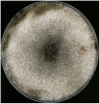A comparative study on biodegradation of low density polyethylene bags by a Rhizopus arrhizus SLNEA1 strain in batch and continuous cultures
- PMID: 39348047
- PMCID: PMC11711581
- DOI: 10.1007/s42770-024-01487-8
A comparative study on biodegradation of low density polyethylene bags by a Rhizopus arrhizus SLNEA1 strain in batch and continuous cultures
Abstract
Biodegradation poses a challenge for environmentalists and scientific community, offering a potential solution to the plastic waste problem. This study aims to investigate the biological degradation of low-density polyethylene (LDPE) bags by a fungus in both batch and continuous cultures, with the goal of identifying an eco-friendly and cost-effective waste management strategy. The fungal strain Rhizopus arrhizus SLNEA1, isolated from a landfill located in northeastern Algeria, was tested for its capability to degrade LDPE films and utilize them as a sole carbon source in batch (α-LDPE) and continuous (γ-LDPE) cultures. The results indicated a higher rate of weight loss for γ-LDPE (29.74%) compared to α-LDPE (23.77%). The biodegradation effect was examined using scanning electron microscopy (SEM), Energy Dispersive X-ray Spectroscopy (EDS) and Attenuated Total Reflectance-Fourier Transform Infrared (ATR-FTIR) to evaluate morphological and chemical changes in LDPE samples, highlighting alterations of LDPE films through cracks, veins and holes under SEM and chemical transformation and appearance of new functional groups in the FTIR data. Rhizopus arrhizus SLNEA1 demonstrated the ability to break down and utilize LDPE films as a carbon source. This isolate shows promise for LDPE biodegradation applications, which may be leveraged for the development of future plastic degradation systems involving fungi.
Keywords: Rhizopus arrhizus; . Biodegradation; Batch culture; Continuous culture; LDPE films.
© 2024. The Author(s) under exclusive licence to Sociedade Brasileira de Microbiologia.
Conflict of interest statement
Declarations. Conflict of interest: On behalf of all authors, the corresponding author states that there is no conflict of interest.
Figures















References
-
- Abraham J, Ghosh E, Mukherjee P, Gajendiran A (2016) Microbial degradation of low density polyethylene. Environ Prog Sustain Energy 36:147–154. 10.1002/ep.12467
-
- Plummer C, Bourban P, Månson J (2001) Polymer Matrix composites: matrices and Processing. Ref Module Mater Sci Mater Eng 7388–7396. 10.1016/B978-0-12-803581-8.02386-9
-
- Lu S, Qu R, Forcada J (2009) Preparation of magnetic polymeric composite nanoparticles by seeded emulsion polymerization. Mater Lett 63:770–772. 10.1016/j.matlet.2008.12.045
-
- Rao JP, Geckeler KE (2011) Polymer nanoparticles: preparation techniques and size-control parameters. Prog Polym Sci 36:887–913. 10.1016/j.progpolymsci.2011.01.001
Publication types
MeSH terms
Substances
LinkOut - more resources
Full Text Sources
Miscellaneous

